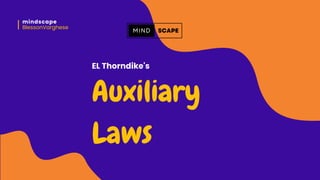Auxiliary Laws EL Thprndike
•
0 likes•129 views
In addition to his famous Law of Effect, Thorndike also proposed several auxiliary laws that further explained the process of learning. These auxiliary laws provide a comprehensive framework for understanding how learning occurs. By applying these principles, educators and learners can create optimal conditions for effective learning and behavior modification.
Report
Share
Report
Share
Download to read offline

Recommended
Recommended
More Related Content
What's hot
What's hot (20)
EDWARD THORNDIKE-THEORY OF CONNECTIONISNM- LUMANOG, MARY KRISTINE M..pptx

EDWARD THORNDIKE-THEORY OF CONNECTIONISNM- LUMANOG, MARY KRISTINE M..pptx
Conditioning theory of Edward Thorndike-Connectionism

Conditioning theory of Edward Thorndike-Connectionism
Similar to Auxiliary Laws EL Thprndike
Similar to Auxiliary Laws EL Thprndike (20)
BEHAVIORISM.PPT in Facilitating Learner Centered Teaching.pptx

BEHAVIORISM.PPT in Facilitating Learner Centered Teaching.pptx
CH. 4 LEARNING, MEMORY, AND INTELLIGENCELearning is defined

CH. 4 LEARNING, MEMORY, AND INTELLIGENCELearning is defined
More from Blesson Varghese
More from Blesson Varghese (7)
Recently uploaded
Making communications land - Are they received and understood as intended? webinar
Thursday 2 May 2024
A joint webinar created by the APM Enabling Change and APM People Interest Networks, this is the third of our three part series on Making Communications Land.
presented by
Ian Cribbes, Director, IMC&T Ltd
@cribbesheet
The link to the write up page and resources of this webinar:
https://www.apm.org.uk/news/making-communications-land-are-they-received-and-understood-as-intended-webinar/
Content description:
How do we ensure that what we have communicated was received and understood as we intended and how do we course correct if it has not.Making communications land - Are they received and understood as intended? we...

Making communications land - Are they received and understood as intended? we...Association for Project Management
https://app.box.com/s/x7vf0j7xaxl2hlczxm3ny497y4yto33i80 ĐỀ THI THỬ TUYỂN SINH TIẾNG ANH VÀO 10 SỞ GD – ĐT THÀNH PHỐ HỒ CHÍ MINH NĂ...

80 ĐỀ THI THỬ TUYỂN SINH TIẾNG ANH VÀO 10 SỞ GD – ĐT THÀNH PHỐ HỒ CHÍ MINH NĂ...Nguyen Thanh Tu Collection
https://app.box.com/s/7hlvjxjalkrik7fb082xx3jk7xd7liz3TỔNG ÔN TẬP THI VÀO LỚP 10 MÔN TIẾNG ANH NĂM HỌC 2023 - 2024 CÓ ĐÁP ÁN (NGỮ Â...

TỔNG ÔN TẬP THI VÀO LỚP 10 MÔN TIẾNG ANH NĂM HỌC 2023 - 2024 CÓ ĐÁP ÁN (NGỮ Â...Nguyen Thanh Tu Collection
Recently uploaded (20)
Interdisciplinary_Insights_Data_Collection_Methods.pptx

Interdisciplinary_Insights_Data_Collection_Methods.pptx
Unit 3 Emotional Intelligence and Spiritual Intelligence.pdf

Unit 3 Emotional Intelligence and Spiritual Intelligence.pdf
Making communications land - Are they received and understood as intended? we...

Making communications land - Are they received and understood as intended? we...
Fostering Friendships - Enhancing Social Bonds in the Classroom

Fostering Friendships - Enhancing Social Bonds in the Classroom
Beyond_Borders_Understanding_Anime_and_Manga_Fandom_A_Comprehensive_Audience_...

Beyond_Borders_Understanding_Anime_and_Manga_Fandom_A_Comprehensive_Audience_...
Food safety_Challenges food safety laboratories_.pdf

Food safety_Challenges food safety laboratories_.pdf
Unit-V; Pricing (Pharma Marketing Management).pptx

Unit-V; Pricing (Pharma Marketing Management).pptx
ICT role in 21st century education and it's challenges.

ICT role in 21st century education and it's challenges.
80 ĐỀ THI THỬ TUYỂN SINH TIẾNG ANH VÀO 10 SỞ GD – ĐT THÀNH PHỐ HỒ CHÍ MINH NĂ...

80 ĐỀ THI THỬ TUYỂN SINH TIẾNG ANH VÀO 10 SỞ GD – ĐT THÀNH PHỐ HỒ CHÍ MINH NĂ...
Sensory_Experience_and_Emotional_Resonance_in_Gabriel_Okaras_The_Piano_and_Th...

Sensory_Experience_and_Emotional_Resonance_in_Gabriel_Okaras_The_Piano_and_Th...
Python Notes for mca i year students osmania university.docx

Python Notes for mca i year students osmania university.docx
TỔNG ÔN TẬP THI VÀO LỚP 10 MÔN TIẾNG ANH NĂM HỌC 2023 - 2024 CÓ ĐÁP ÁN (NGỮ Â...

TỔNG ÔN TẬP THI VÀO LỚP 10 MÔN TIẾNG ANH NĂM HỌC 2023 - 2024 CÓ ĐÁP ÁN (NGỮ Â...
Auxiliary Laws EL Thprndike
- 2. "The first response made in a given situation tends to be the most strongly associated with that situation." In other words, the first response that an organism makes in a particular situation is more likely to be repeated in that same situation in the future. LAW OF PRIMACY
- 3. It states that the most recent information we receive has a stronger impact on our memory and perception than earlier information. This means that when we are presented with a series of stimuli, the last stimulus we encounter is often the most memorable and influential in shaping our overall perception. LAW OF RECENCY
- 4. LAW OF INTENSITY It is a psychological principle that states that the greater the intensity of a stimulus, the more likely it is to produce a response. This means that a stronger or more intense stimulus is more likely to elicit a response than a weaker or less intense stimulus. If a stimulus is too intense, it can be overwhelming and lead to a decrease in response, known as sensory adaptation.
- 5. LAW OF It is a psychological principle that states that the stronger a stimulus, the greater the number of possible responses it can evoke. This means that when a stimulus is intense or strong, it can elicit a variety of responses from an organism, rather than a single, specific response. MULTIPLE RESPONSE
- 6. 02. 01. LAW OF SET ATTITUDE It states that a person's attitude towards a specific object or situation can strongly influence their behavior and actions towards that object or situation. This means that if someone has a set attitude towards something, their behavior towards it is likely to be consistent with that attitude.
- 7. It is a psychological principle that states that people tend to understand and learn new information by relating it to previously learned information and experiences. This means that when someone is presented with new information, they attempt to make sense of it by comparing and assimilating it to what they already know. LAW OF ANALOGY
- 8. LAW OF ASSOCIATIVE SHIFTING This law states that any response may be elicited from the learner, of which he is capable, in association with any situation to which he is sensitive. In other words, any response that is possible can be linked with any stimulus. It describes a process whereby a response may shift from one stimulus to another.